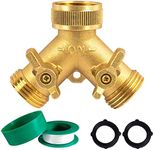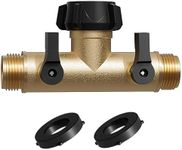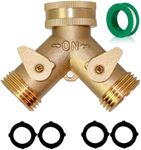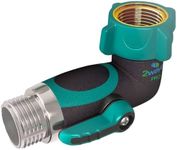Buying Guide for the Best Garden Hose Splitters
Choosing the right garden hose splitter can make watering your garden or managing multiple hoses much easier. A splitter allows you to connect more than one hose to a single outdoor faucet, giving you flexibility and convenience. When shopping for a garden hose splitter, it's important to consider how many hoses you want to use, the durability of the materials, how easy it is to operate, and whether it will fit your faucet and hoses. Understanding the key features will help you pick a splitter that matches your gardening needs and lasts through many seasons.Number of OutletsThe number of outlets refers to how many hoses you can connect to the splitter at once. Most common splitters have two outlets (also called a 'Y' splitter), but you can also find models with three or four outlets. If you only need to run two hoses, a two-way splitter is usually enough. If you want to water different areas at the same time or use one hose for watering and another for washing, a splitter with more outlets might be better. Think about how many hoses you want to use at once and choose a splitter with enough outlets to match your needs.
MaterialGarden hose splitters are typically made from materials like plastic, brass, or zinc. Brass is known for being very durable and resistant to rust, making it a good choice for long-term outdoor use. Zinc is also sturdy but may not last as long as brass. Plastic splitters are lightweight and less expensive, but they can crack or break more easily, especially if left in the sun. If you want a splitter that will last through many seasons and handle rough use, go for metal options like brass. If you only need it for occasional use or want something lightweight, plastic might be enough.
Valve ControlValve control means how you turn the water on or off for each hose connected to the splitter. Most splitters have individual levers or switches for each outlet, so you can control the flow to each hose separately. Some valves are larger and easier to grip, which is helpful if you have limited hand strength or will be adjusting them often. If you want to easily manage water flow to different hoses, look for a splitter with smooth, easy-to-turn valves. If you plan to set it and forget it, the style of the valve may be less important.
Thread CompatibilityThread compatibility refers to whether the splitter will fit your outdoor faucet and hoses. Most garden hoses and faucets use standard sizes, but it's always good to check that the splitter matches the threads on your equipment. If you have a non-standard faucet or hose, you may need an adapter. Make sure to check the size and type of threads before buying to avoid leaks or connection problems.
Leak ResistanceLeak resistance is about how well the splitter prevents water from dripping or spraying out at the connections. Good splitters have rubber washers or seals inside the connectors to help stop leaks. Some also have reinforced joints or extra-tight fittings. If you want to avoid wasting water and keep your connections dry, look for a splitter with good seals and a reputation for leak resistance. If you notice leaks, sometimes replacing the washer can help.
Ease of InstallationEase of installation means how simple it is to attach the splitter to your faucet and hoses. Some splitters have large, easy-to-turn connectors that you can tighten by hand, while others may require a wrench. If you want a hassle-free setup, look for a splitter that advertises tool-free installation and has comfortable grips. If you don't mind using tools, installation style may not matter as much.
















